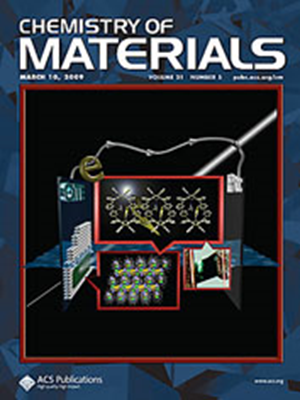Colossal Thermal Expansion in Ca-Substituted PbCrO3
IF 7.2
2区 材料科学
Q2 CHEMISTRY, PHYSICAL
引用次数: 0
Abstract
Colossal thermal expansion, 11.9% volume expansion on heating, was observed in Pb0.7Ca0.3CrO3. The parent compound, PbCrO3, had been known to have a characteristic Pb2+0.5Pb4+0.5Cr3+O3 charge distribution with a glassy distribution of Pb2+ and Pb4+ in ambient conditions and undergoes a charge transfer transition to the Pb2+Cr4+O3 high-pressure phase at 2.5 GPa. It decomposes at 720 K without such a transition when heated at ambient pressure. Our in-situ synchrotron X-ray diffraction study revealed a temperature-induced phase transition from Pb2+Cr4+O3 to Pb2+0.5Pb4+0.5Cr3+O3 at moderate pressures between 2 and 3.5 GPa. Ca substitution for Pb shifted the phase boundary in the pressure–temperature space, and essentially the same charge transfer transition was caused by heating at ambient pressure. A remarkable volume change of 11.9% occurred, corresponding to a colossal linear thermal expansion coefficient of 550 ppm/K─an unprecedented value in oxide ceramics.

求助全文
约1分钟内获得全文
求助全文
来源期刊

Chemistry of Materials
工程技术-材料科学:综合
CiteScore
14.10
自引率
5.80%
发文量
929
审稿时长
1.5 months
期刊介绍:
The journal Chemistry of Materials focuses on publishing original research at the intersection of materials science and chemistry. The studies published in the journal involve chemistry as a prominent component and explore topics such as the design, synthesis, characterization, processing, understanding, and application of functional or potentially functional materials. The journal covers various areas of interest, including inorganic and organic solid-state chemistry, nanomaterials, biomaterials, thin films and polymers, and composite/hybrid materials. The journal particularly seeks papers that highlight the creation or development of innovative materials with novel optical, electrical, magnetic, catalytic, or mechanical properties. It is essential that manuscripts on these topics have a primary focus on the chemistry of materials and represent a significant advancement compared to prior research. Before external reviews are sought, submitted manuscripts undergo a review process by a minimum of two editors to ensure their appropriateness for the journal and the presence of sufficient evidence of a significant advance that will be of broad interest to the materials chemistry community.
 求助内容:
求助内容: 应助结果提醒方式:
应助结果提醒方式:


